Washing paddles are one of the oldest laundry tools used for cleaning clothes. They are usually made out of wood and shaped like a cricket bat.
Not sure if a cricket bat was introduced first or if it was the washing paddles as they look quite similar and both serve the same purpose i.e. to smash.
Nevertheless, we will stick to the laundry thing for now.
In India, washing paddles are quite popular and are known as Thaapi, Thapki, Dhoka, or washing bats.
They are also known as washing beetle, laundry bat, battledore, etc.
In this article, you will learn what are washing paddles and how to use them effectively as a laundry tool.
Moreover, you will also learn the easy steps to make your own washing paddle at home.
Table of Contents
What are washing paddles?
In the early days, washing paddles were among the most popular laundry instruments.
They still exist and are quite popular, especially in rural areas. Moreover, they are also used in urban dwellings by many.
Washing paddles are simply a hand tool used in laundry chores. They are used to treat clothes during hand washing to remove excess dirt and stains from them.
They are made of durable wood and have a small handle on the side.
These handles provide a firm grip to hold them during the act of beating the garments. It helps to remove dirt, especially from bulky fabrics.
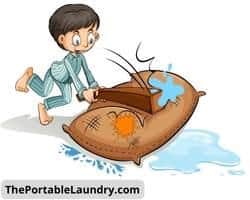
Washing bats are simply used to beat the clothes after soaking them in the water mixed with detergents.
They are typically used on wooden washing boards or flat surfaces.
A washing board is another form of laundry tool with a rectangular frame.
The clothes are scrubbed on their surface to remove dirt and stains and later treated with bats.
Washing paddles can be used on any solid and flat surface such as a log of wood or a piece of flat stone, and or simply a flat surface.
How do you use a washing paddle?

Washing Paddles are used to remove dirt from clothing in the hand wash process.
Step 1: At first, the garments are separated to be washed using a Washing paddle from a load of laundry. Most often larger sheets and bulky items are preferred to clean using a washing paddle. Fabrics such as denim, bedsheets, carpets, jute, etc.
Step 2: The fabrics are pre-treated by soaking in a large tub mixed with water and soap before washing.
Earlier when detergents weren’t that popular, the garments were usually soaked in plain water.
Alternatively, they were laid flat on the dedicated washing surface in order to get them wet by pouring water on them.
Then the laundry soap was thoroughly applied using hands all over the garments.
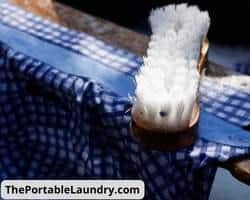
So, apply detergents OR soap to all the garments.
Step 3: Remove the fabrics and lay them on a flat surface and start the gentle beating process.
Step 4: Rinse the fabrics with clean water and you can scrub them with a washing brush. The brushing of garments can be repeated after the first rinse. It will make sure that excess dirt, stains, and soap residues are discharged off the garments.
Step 5: Now, you can rinse them with clean water.
Step 6: Put them to air dry after squeezing out the excess water from the garments.
What are Washing Paddles Made Of?
Washing Paddles are made out of durable and strong wood. They are carved thick enough to bear the beating impact, hence they last longer.
These wooden washing paddles are mostly carved by carpenters.
Both the front and back of wooden paddles are typically flat, so they can be used from either side.
These days, washing paddles are also made from plastic with the highest quality raw materials.
Manufacturers use various sophisticated technologies in the making of sturdy, durable, and unbreakable washing bats.
They do not need drying as you can simply wipe them with a cloth after every use.
With that said, It can be tricky at times to hold its handle in soapy conditions.
Can you make a washing paddle at home?
Yes, you can easily carve a washing paddle out of wood at home with the right tools.
Let us look into the below steps and make your own washing paddle at home.
You will need a woodcutter, a small block of strong wood, a measuring instrument, and a marker.
Step 1: Choose a right wooden block
Simply grab a cubical wooden block and make sure to carve the entire washing paddle using a single wooden block. (Do not separate the handle for attachment).
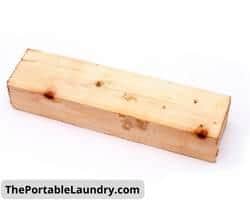
Step 2: The measurement
As per your comfort use a specific length. The average length of washing bats is around 18 to 24 inches.
Therefore, when you are using a cubical block of wood, make sure its length is around 24 inches (2 feet).
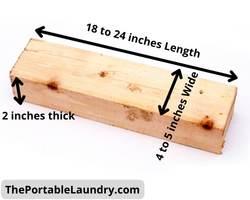
For handles make sure the size is around 6 to 8 inches and the remaining length can be left for the body.
Step 3: Make a diagram
You can choose the wider sides to draw the shape of the bat. You can make use of the marker and a measurement tape.
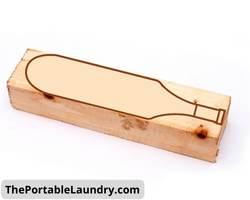
Step 4: The cutting
You may use a hand saw woodcutter and start cutting as per the markings of the diagram.
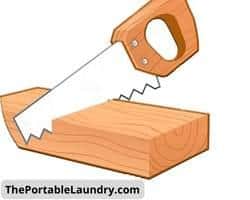
You can use a machine to get the job done quickly.
Make sure to cut the edges fine and polish the corners using sand papers suitable for wood.
If you are unsure or not confident enough, hire a carpenter to do the cutting.
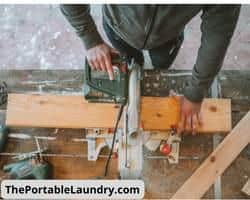
Step 5: Work On Fine Edges
Once the washing paddle is carved out with the cutting task you can now work on fine edges.
Now, use a wooden polish paper and scrub the washing paddle from all the sides to smoothen its surface.
Make sure to work on all the sharp and rough edges thoroughly.
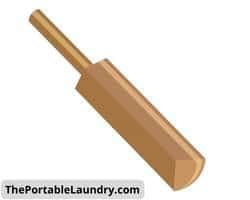
Lastly, you may also apply wooden polish to enhance its looks and to make it durable for wet conditions.
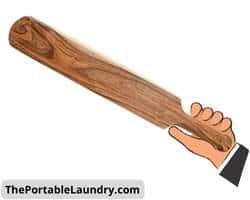
Your wooden paddle is ready for your laundry.
What are the benefits of a washing paddle?
Those who love to do laundry by hand will find washing paddles useful.
- Washing Paddles can remove dirt and stains from heavily soiled fabrics with ease.
- It takes less time to clean the stubborn stains and remove dirt from your fabrics.
- They are durable and also save on energy bills by using less water and no power consumption.
- Easy to carry along wherever you go.
What are the drawbacks of a washing paddle?
As a handy tool for laundry, they do have a few drawbacks.
Here are a few of them.
- It requires physical efforts in the cleaning process.
- They are not suitable for all fabric types such as delicates.
- Repeatedly cleaning the clothes using a washing paddle can be harsh on some fabrics.
- With any negligence, it can break the buttons, hooks, and zips in no time.
- Not available as a buying option in most places, you will need to get one carved out of wood.
Washing Paddles Specific Use Cases
Heavy Soiled Fabrics
Washing paddles are most effective for fabrics that are heavily soiled or stained, such as work clothes, outdoor gear, and industrial uniforms.
Off-Grid Living
Washing paddles are invaluable for individuals living in remote areas without access to modern utilities.
Off-grid cabins, camps, or remote homesteads often lack electricity and running water.
In such cases, washing paddles are a sustainable and practical choice for laundry.
They enable residents to maintain clean clothing without relying on traditional washing machines.
Camping and Backpacking
When camping or backpacking, space and weight are at a premium.
Carrying a portable washing machine is impractical, but packing a lightweight washing paddle is a game-changer.
Campers can use them to refresh clothes during extended outdoor trips, ensuring they have clean garments without the need for electricity or extensive water resources.
Travelers
Travelers who prefer packing light can utilize washing paddles to save on luggage space and laundry costs.
Eco-Conscious Individuals
For environmentally conscious individuals, washing paddles align with their sustainability goals.
These users appreciate the minimal water usage and zero electricity consumption of washing paddles.
They reduce their environmental impact by choosing this manual laundry method, which conserves resources and minimizes energy consumption.
Workwear and Industrial Use
Industries that involve heavy labor, such as construction, agriculture, or automotive repair, often require durable workwear.
Washing paddles are effective at removing tough stains and dirt from these work garments.
They are commonly used by workers in such fields to ensure their uniforms remain in good condition.
Homesteads and Farms
In rural areas, homesteads, and farms, where large families or communities may reside, washing paddles provide a cost-effective method for handling substantial amounts of laundry.
They are ideal for washing bed linens, blankets, and other heavy fabrics that accumulate on farms.
Crafting and DIY Enthusiasts
Crafters and DIY enthusiasts can use washing paddles to maintain and clean textiles used in their projects.
These paddles are an excellent choice for handling fabric pieces, upholstery, or other materials in workshops and crafting spaces.
Final Thoughts
If you love to do laundry in the vintage style then these washing paddles are a great choice for you.
Simply grab one and start beating your damp and dirty fabrics.
Washing paddles are a handy tool that can help you save on your energy bills by simply limiting the use of washing machines.
It doesn’t matter if they aren’t available for sale in your region.
Simply grab a wooden block and carve a wooden paddle if you like to do woodworking or simply take help from a professional carpenter.
Lastly, It is advised to make use of wood from a dead tree or from a used piece of a wooden block. Try not to harm live trees, together we can save our planet.
Frequently Asked Questions
What is the ideal length of a washing paddle?
The ideal length of a washing paddle is about 18 inches long for personal laundry. It can vary depending on your comfort and laundry style or size.
Which is better plastic or wooden washing paddle?
Washing paddles made of wood have been used for ages. Whereas paddles made out of plastic are a new trend. Although wooden bats need to be dried which is a disadvantage, They can give you a firm grip in soapy conditions.
Can I use a cricket bat as a washing paddle?
Cricket bats are designed for sporting events whereas washing bats accomplish the laundry needs. Washing paddles are used to do all the beating jobs in wet conditions. Whereas, a cricket bat may not be able to bear all the impact in such moist conditions all the time. Therefore, it is not recommended to use a cricket bat as an alternative to washing paddles.
Where can I buy a washing paddle?
Washing bats are available on online platforms such as Amazon. You may also buy them from local stores that supply laundry tools. If they are not available at your place, then you can make one yourself using the right tools.
Are washing paddles durable?
The durability depends on the quality of wood used to make a washing paddle. They are durable in most cases and last for years. Even if they break down it is less expensive to get a replacement.
You May Also Like
- Laundry Bags: 11 Commonly Asked Questions Answered
- What Is A Laundromat? (Explained)
- What Is An Anti-Vibration Pad In Washing Machine? (Explained)
- What is a Steam Wash In LG washing Machine?
- What Happens If You Wash Wool in the Washing Machine?
- What is a portable laundry hamper? (Explained)
- What is Pulsator Roller in a Washing Machine?
- Difference Between Laundry Sink And Utility Sink (Explained)
- Laundromats OR Home Laundry? (Which is Cheaper?)
- Which is Better Laundry or Dry Cleaning? (Explained)
- Five Stages Of Laundry Process (Explained)
- 51 Laundry Care Symbols Explained
- Laundry Pods: 12 Answers you should know





